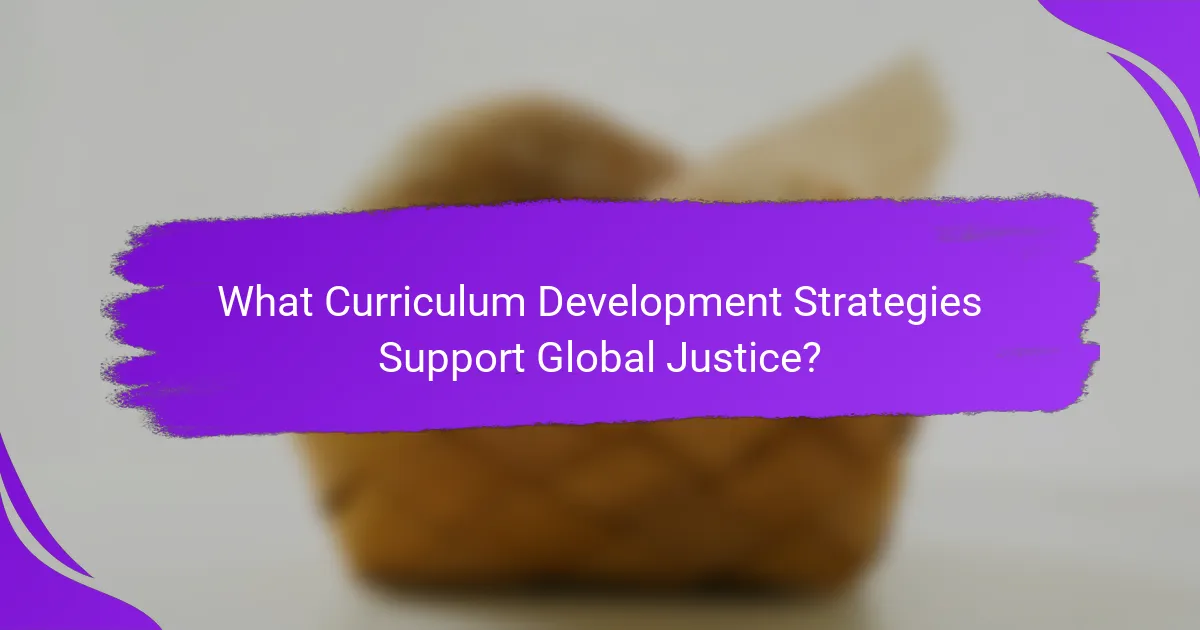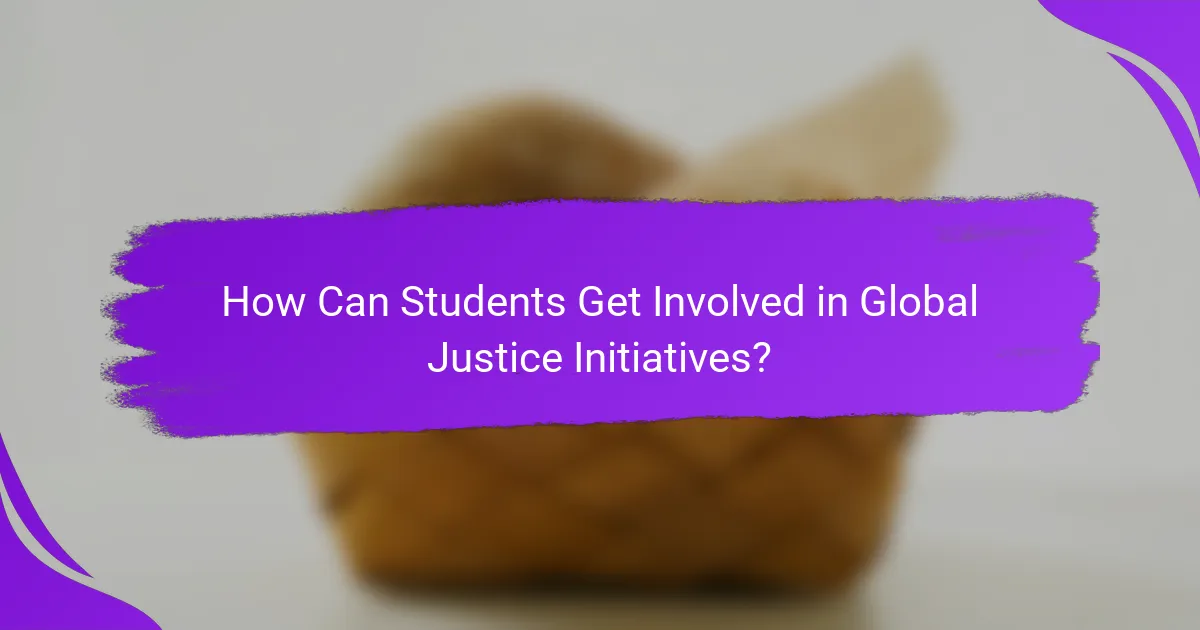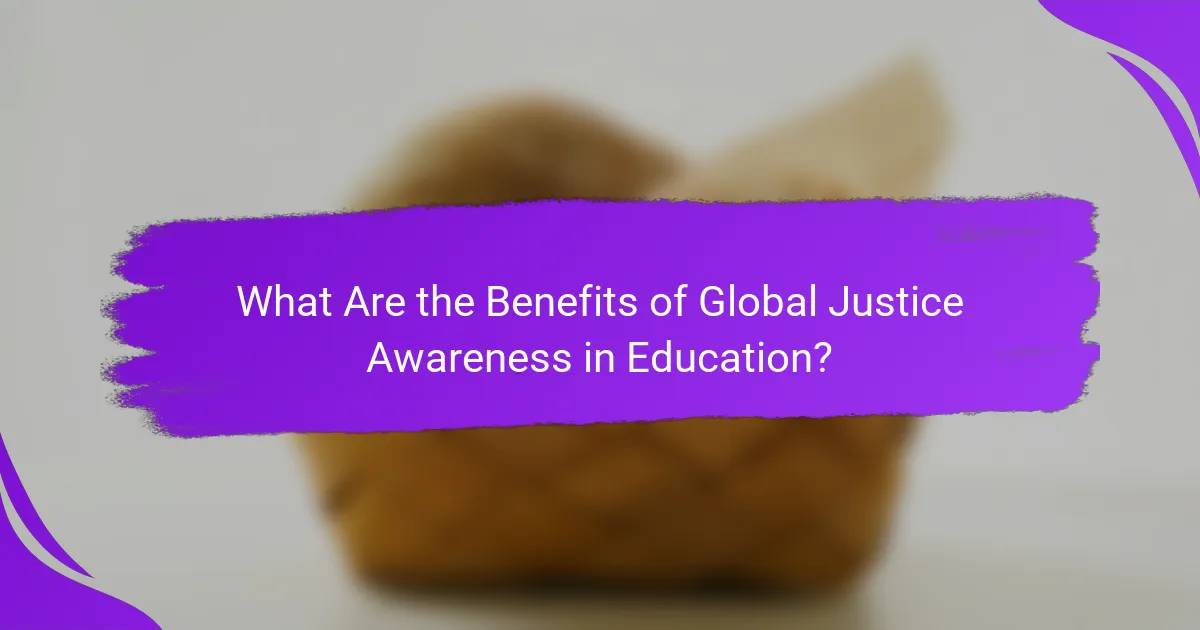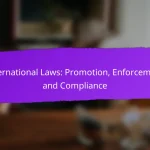Global justice awareness in schools is essential for cultivating informed and engaged citizens. By integrating relevant topics into the curriculum and fostering student involvement, educational institutions can create a dynamic environment that encourages critical thinking and empathy. Through partnerships and hands-on projects, students can actively participate in initiatives that address pressing global issues, equipping them with the skills needed to make a positive impact.

How Can Schools Implement Global Justice Programs?
Schools can implement global justice programs by developing partnerships, integrating relevant topics into the curriculum, and encouraging student involvement. These initiatives foster awareness and engagement with global issues, preparing students to become informed global citizens.
Partnerships with NGOs
Establishing partnerships with non-governmental organizations (NGOs) can enhance global justice programs in schools. NGOs often provide resources, expertise, and real-world perspectives that enrich educational experiences. Schools should seek local or international NGOs that align with their values and objectives.
For effective collaboration, schools can invite NGO representatives for workshops, guest lectures, or field trips. This direct involvement helps students understand the complexities of global justice issues and encourages critical thinking.
Curriculum Integration
Integrating global justice themes into the curriculum ensures that students engage with these topics across various subjects. Schools can incorporate discussions on human rights, environmental justice, and economic inequality into history, social studies, and even science classes.
Teachers should aim to create interdisciplinary projects that allow students to explore global justice issues in depth. For example, a project could involve researching the impact of climate change on vulnerable populations, linking environmental science with social studies.
Student-Led Initiatives
Encouraging student-led initiatives empowers learners to take ownership of global justice issues. Schools can support clubs or organizations focused on advocacy, fundraising, or awareness campaigns related to global justice.
Students might organize events such as awareness days, fundraisers for specific causes, or community service projects. Providing guidance and resources can help students effectively plan and execute these initiatives, fostering leadership skills.
Community Engagement
Engaging the local community is vital for the success of global justice programs. Schools can collaborate with local organizations, businesses, and community leaders to create a supportive environment for these initiatives.
Community forums, workshops, and volunteer opportunities can help bridge the gap between global issues and local realities. Schools should encourage students to participate in community service that addresses global justice themes, reinforcing their learning through practical experience.
Funding Opportunities
Securing funding is essential for implementing global justice programs effectively. Schools can explore various funding sources, including grants from educational foundations, local businesses, and government programs focused on social justice.
Creating a detailed proposal outlining the program’s objectives, expected outcomes, and budget can increase the chances of obtaining funding. Schools should also consider organizing fundraising events to support their initiatives, engaging students and the community in the process.

What Curriculum Development Strategies Support Global Justice?
Curriculum development strategies that support global justice focus on fostering critical thinking, empathy, and active participation among students. These strategies emphasize interdisciplinary learning, hands-on projects, diverse perspectives, and effective assessment methods to create a comprehensive understanding of global justice issues.
Interdisciplinary Approaches
Interdisciplinary approaches integrate multiple subjects to provide a holistic view of global justice. For example, a unit might combine history, geography, and social studies to explore the impact of colonialism on contemporary social issues. This method encourages students to make connections across disciplines, enhancing their critical thinking skills.
Teachers can collaborate to design projects that require knowledge from various subjects, allowing students to see the interconnectedness of global issues. This approach not only deepens understanding but also prepares students for real-world problem-solving.
Project-Based Learning
Project-based learning (PBL) engages students in real-world challenges related to global justice, fostering active learning and collaboration. Students might work on projects that address local or global issues, such as poverty or climate change, allowing them to apply their knowledge in practical ways.
Effective PBL should include clear objectives, a timeline, and opportunities for reflection. For instance, students could create a campaign to raise awareness about a specific issue, which helps them develop research, communication, and teamwork skills.
Inclusion of Diverse Perspectives
Incorporating diverse perspectives is crucial for a well-rounded understanding of global justice. Curriculum should include voices from various cultures, genders, and socioeconomic backgrounds to reflect the complexity of global issues. This can be achieved through literature, guest speakers, and multimedia resources.
Encouraging discussions around these diverse viewpoints helps students develop empathy and critical analysis skills. Schools can facilitate this by creating a safe environment for dialogue, where students feel comfortable sharing their thoughts and experiences.
Assessment Methods
Assessment methods in global justice education should evaluate not only knowledge but also skills such as critical thinking and collaboration. Traditional tests may not fully capture student understanding, so alternative assessments like portfolios, presentations, and peer evaluations can be more effective.
Teachers should provide clear rubrics that outline expectations for projects and presentations, allowing students to understand how their work will be evaluated. Regular feedback throughout the learning process can also help students improve and engage more deeply with the material.

How Can Students Get Involved in Global Justice Initiatives?
Students can engage in global justice initiatives through various programs that promote awareness and action. These opportunities allow them to contribute to meaningful causes while developing skills and knowledge in social justice issues.
Volunteer Programs
Volunteer programs provide students with hands-on experience in global justice efforts. These can include working with local NGOs, participating in community service projects, or joining international missions that focus on human rights, poverty alleviation, or environmental sustainability.
To get involved, students should research organizations that align with their interests and reach out to inquire about available opportunities. Many programs offer flexible schedules to accommodate school commitments.
Advocacy Campaigns
Advocacy campaigns empower students to raise awareness about global justice issues. This can involve organizing events, creating social media campaigns, or participating in petitions aimed at influencing policy changes.
Students can collaborate with established organizations or initiate their own campaigns. It’s essential to clearly define the campaign’s goals and target audience to maximize impact.
Peer Education
Peer education programs enable students to educate their classmates about global justice topics. This can include workshops, presentations, or discussion groups that foster dialogue and critical thinking.
Students should focus on creating engaging materials and fostering an inclusive environment where all voices are heard. Training sessions can help prepare peer educators for effective communication and facilitation.
Extracurricular Activities
Extracurricular activities such as clubs or student organizations dedicated to global justice can enhance student involvement. These groups often host events, discussions, and community outreach programs that promote social awareness.
Joining or starting a club can provide a platform for students to collaborate on projects, share resources, and support each other in their advocacy efforts. Regular meetings and activities can help maintain momentum and engagement among members.

What Are the Benefits of Global Justice Awareness in Education?
Global justice awareness in education fosters a deeper understanding of social, economic, and political issues that affect communities worldwide. By integrating this awareness into school programs, students develop critical skills that prepare them for active participation in a global society.
Enhanced Critical Thinking
Global justice awareness encourages students to analyze complex issues from multiple perspectives. This critical thinking development helps them evaluate information, identify biases, and construct well-reasoned arguments.
For instance, when discussing topics like climate change or human rights, students can engage in debates that require them to consider various viewpoints and the implications of different solutions. This practice not only sharpens their analytical skills but also prepares them for real-world problem-solving.
Increased Empathy
Understanding global justice issues cultivates empathy among students by exposing them to diverse cultures and experiences. This emotional connection can motivate them to take action and support marginalized communities.
Activities such as virtual exchanges with students from different countries or projects that highlight local and global inequalities can enhance this empathetic engagement. As students learn about the struggles of others, they are more likely to develop a sense of responsibility and commitment to social justice.
Global Citizenship Skills
Global justice awareness equips students with essential global citizenship skills, such as collaboration, communication, and advocacy. These skills are vital for navigating an interconnected world and addressing global challenges.
Schools can foster these skills through service-learning projects and partnerships with international organizations. By participating in initiatives that promote social change, students gain practical experience in teamwork and leadership, preparing them for future roles as informed global citizens.

What Frameworks Guide Global Justice Education?
Global justice education is guided by various frameworks that emphasize equity, human rights, and social responsibility. These frameworks help shape curriculum development and student involvement in schools, ensuring that educational programs promote awareness and action towards global justice issues.
Human Rights Framework
The human rights framework focuses on the fundamental rights and freedoms that belong to every individual. It emphasizes the importance of teaching students about international human rights laws and conventions, such as the Universal Declaration of Human Rights. Schools can incorporate lessons on human rights through case studies, discussions, and projects that encourage critical thinking about justice and equality.
In practice, educators can engage students by exploring local and global human rights issues, allowing them to analyze real-world situations. Activities such as debates, role-playing, and community service projects can deepen understanding and foster empathy.
Sustainable Development Goals (SDGs)
The Sustainable Development Goals (SDGs) provide a comprehensive framework for addressing global challenges, including poverty, inequality, and climate change. Schools can align their curricula with the 17 SDGs, encouraging students to explore how these goals relate to justice and sustainability. This approach promotes interdisciplinary learning and critical analysis of global issues.
For effective implementation, educators should integrate SDGs into various subjects, such as science, social studies, and economics. Projects that involve local communities can help students see the relevance of the SDGs in their own lives and inspire them to take action.
Social Justice Education
Social justice education aims to empower students to challenge injustices and advocate for change. This framework encourages critical examination of societal structures and promotes awareness of issues such as racism, sexism, and economic inequality. Incorporating social justice themes into the curriculum can help students develop a sense of agency and responsibility.
Teachers can facilitate discussions on social justice topics and encourage students to participate in activism and community engagement. Creating a safe and inclusive classroom environment is essential for fostering open dialogue and encouraging diverse perspectives.


